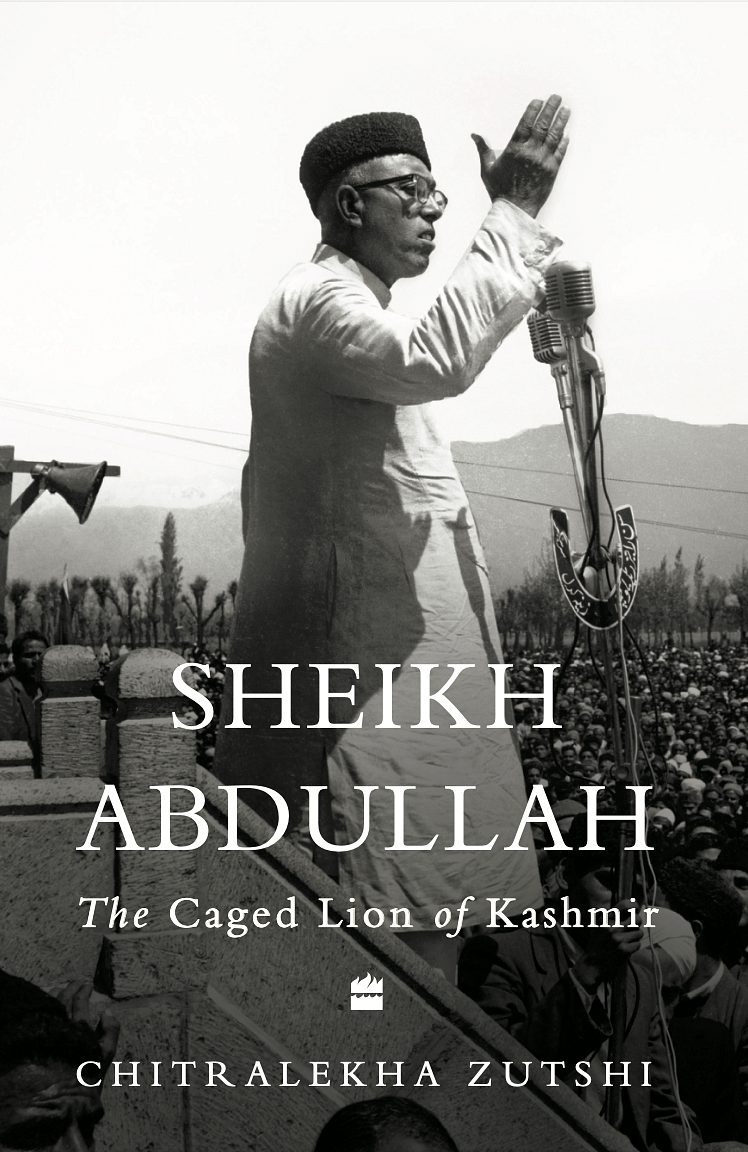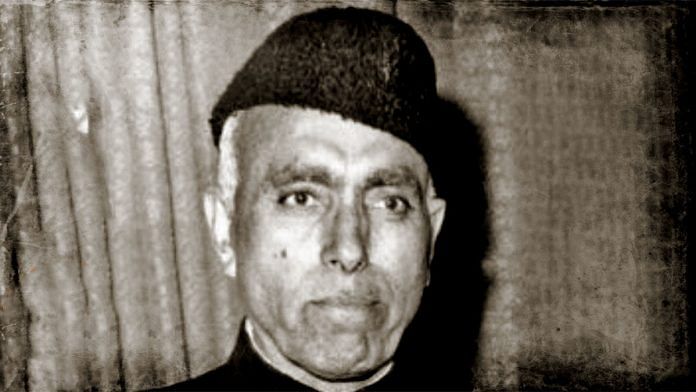The All Jammu and Kashmir Praja Parishad was founded in 1947 by Balraj Madhok, a Rashtriya Swayamsevak Sangh (RSS) activist, to represent the interests of the Hindus of Jammu and to safeguard their rights from what was considered the anti-Dogra and Kashmir-centric government led by Sheikh Abdullah. Its main objectives were the entire state’s complete integration into India, or barring that, its division along the Ceasefire Line with the state’s integration into India, or barring that, the integration of Jammu and Ladakh into India. The situation at that time, with a divided state granted autonomy within the Indian Union and an NC regime in power, was seen as deleterious to Hindu interests and hence unacceptable. Since the regime did not allow for the existence of opposition parties, the PP became a conduit through which a range of groups within the state with grievances against the NC and its policies could express themselves. The RSS, and later the Bharatiya Jana Sangh, provided support to the party and the agitation that it organized as a means to undercut the Congress government at the centre.
The PP clashed early on with the NC regime, and Abdullah externed Balraj Madhok from the state in 1948. Jammu Hindus resented this deeply, and the Dogras especially could not abide Abdullah’s steady drumbeat against the Maharaja. In general, Jammu Hindus were acutely unhappy with the economic policies of the NC, which they felt were aimed specifically against them. The anger mounted as the nomination papers of the PP candidates running for the constituent assembly elections were rejected by the NC authorities in 1951. The constituent assembly, which Abdullah so proudly proclaimed as the ‘harbour of freedom’ for the people of the state, was seen as a sham by people in Jammu, even those not affiliated with the PP. Soon thereafter, as the negotiations between India and the NC leading to the Delhi Agreement were taking place, the PP, now led by Prem Nath Dogra, organized an agitation calling for the state’s integration into India. The movement demanded ‘Ek Vidhan, Ek Pradhan, Ek Nishaan’ (One Constitution, One Prime Minister, One Flag). The end of the Dogra dynasty with the abdication of Maharaja Hari Singh and the election of his son, Karan Singh, as Sadar-i-Riyasat added fuel to the raging fire.
From the beginning of the agitation, Abdullah was its main object and would remain persona non grata for the Indian Hindu right throughout his political career, even after he had been dismissed. He did not represent the end of autocracy for the people of Jammu; instead, he was the symbol of the transfer of power from Jammu to the Kashmir Valley, from Dogras to Kashmiris, after 200 years. According to Balraj Puri, a member of the NC from Jammu who was expelled from the party by Abdullah, Abdullah expected the people of Jammu to submit to his diktat in the same way as the people of the Valley. But the people of Jammu were too heterogeneous to accept one leader as paramount, especially an individual from the Valley. As Puri pointed out to Nehru in 1950 and 1952, the one-party state that was being run by Abdullah was simply not acceptable to the people of Jammu. Karan Singh, now Sadar-i-Riyasat, was taken aback by the level of sympathy for the agitation that he observed across the province of Jammu in late 1952, and reported to Nehru that it was driven by ‘deep-seated and genuine economic and psychological reasons’, and could not be dismissed ‘as merely the creation of a reactionary clique’.
From the perspective of Jammu, Abdullah came across as at best disinterested and at worst unsympathetic towards its people’s demands. It did not help that the NC did not have very deep roots in the region and the Jammu NC representatives were particularly corrupt individuals with little influence within the regime. As a result, the people of Jammu felt voiceless and unrepresented in the upper echelons of power. Organizations such as the New Kashmir Committee—which was led by Balraj Puri and was against the PP as well as the conflation of the Dogra community with Jammu—were willing to support Abdullah’s regime if he at least attempted to address some of the demands of Jammu and put in place a more democratic administration in the state.
Abdullah’s stifling of all criticism, even from sympathetic quarters, meant that there were no organizations left in Jammu that would stand up for his regime at this time. The newspaper Ranbir is a case in point. Founded in 1924 under the Dogra regime by Mulk Raj Saraf, the newspaper supported Abdullah’s regime and its defence of secular democracy. It recognized the immense pressures faced by Abdullah as he took over the ravaged state and was highly critical of the PP agitation in its early stages. But as the newspaper began to point out the rampant corruption creeping into the various levels of government, the pressure from the regime grew so intense that the newspaper had to shutter its doors in 1950. In his autobiography, Saraf writes that he once pointed out to Abdullah that he had rid the people of one maharaja but imposed many maharajas on them instead. Abdullah grew purple with rage, shouting at Saraf about the reports he was receiving about his changed attitude, and warning him that it would land him in prison if he was not careful. According to Saraf, ‘The Sheikh permitted himself to be surrounded by a set of sycophants who were always busy poisoning his ears to grind their own axe.’ In this case, the Ranbir was a threat to their activities, and therefore, they tried their best to turn the Sheikh against the paper.
Nehru wrote to Abdullah to deal with the PP agitation in both psychological terms and in terms of law and order by parsing out the mischief mongers from those who had real grievances that needed redress. By conciliating the latter group, and with ‘careful handling’, Nehru felt, the agitation would ‘subside’. Abdullah, for his part, did little to bring about any kind of reconciliation with Jammu. His letter to Nehru regarding the agitation is telling because it illustrates how he actually saw the movement, describing it as ‘a violent reaction on the part of Jammu landlords and other upper classes’. He added that the problems facing Jammu were not related to its association with Kashmir or India, but were rather of ‘wretchedness, poverty and degeneration of the vast masses of Jammu people’.
Despite Nehru’s much-publicized visit—accompanied by Maulana Azad and Abdullah himself—to Ladakh in September 1952 to consult with its leadership, by the end of that year, the head lama, Kushak Bakula, had become more vocal on behalf of Ladakh’s separation from J&K and Ladakhi autonomy within the Indian Union. Here again, Nehru—perhaps without realizing that similar advice could apply to his own handling of J&K as a whole—advised Abdullah to ‘create a sensation of self-rule or partnership in self-rule’ in Ladakh before the problem got out of hand. But on the larger issue of the lack of freedom of expression and allowing an opposition in the state that had been raised by Puri, Nehru remained silent.
Abdullah’s repression of the communists came back to haunt him at this stage, as they used the situation in Jammu as an opportunity to raise their own profile at Abdullah’s expense. The changing international scenario, with the USSR taking an overtly pro-India stance on Kashmir at the UN to undermine the Anglo-American bloc and the fact that the Communist Party of India (CPI) had abandoned armed insurrection against the Indian state in favour of participating in the 1951–2 general elections, further turned the communists against Abdullah. In late June 1953, the CPI passed a resolution on Kashmir that stated that it was against an independent Kashmir, supported limited accession of Kashmir to India and called on democratic forces inside and outside the NC to resolve the Kashmir issue. It also endorsed the legitimacy of the Jammu agitation, noting that it was a result of real grievances that the Abdullah government had been unable to address. This deepened the wedge between Jammu and the Kashmir Valley as well as the pro-communist and anti-communist members within the NC.
Since 1951, communist treatises had been asserting that the Kashmir affair was a creation of the imperialist designs of the Anglo-American bloc in which both India and Pakistan were embroiled. By 1952–3, the communists were increasingly convinced that Abdullah was under the thrall of this bloc, which was encouraging his quest for independence. Americans such as the US ambassador Loy Henderson and his wife, both of whom frequented Kashmir in the summers and spent time with Abdullah, were seen as backing his dreams of an independent Kashmir. Adlai Stevenson’s visit to Kashmir in May 1953—during which he held three long talks with Abdullah, gushing afterwards about Kashmiri hospitality and pleading with India and Pakistan to resolve the dispute—added further grist to the mill. Sadiq, recognized as a noted pro communist member of the J&K cabinet, wrote in June 1953 to Mehmooda Ali Shah that the ‘Tall Fool’ was ‘poisoning people’s minds’ and ‘we have decided to expose all his foreign conspiracies and thus defeat him’.
 This excerpt from Sheikh Abdullah: The Caged Lion of Kashmir by Chitralekha Zutshi has been published with permission from HarperCollins India.
This excerpt from Sheikh Abdullah: The Caged Lion of Kashmir by Chitralekha Zutshi has been published with permission from HarperCollins India.



